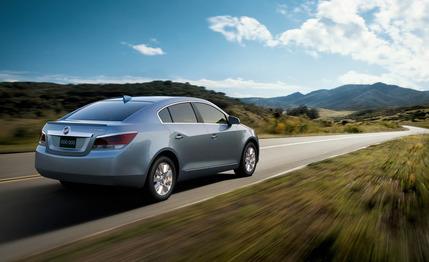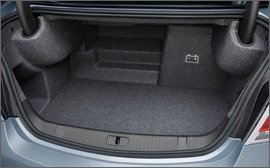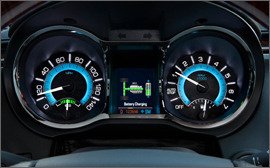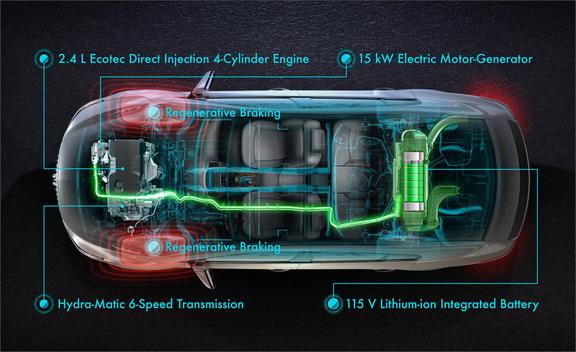
 First Drive Review
First Drive Review
The GM engineers assigned to the LaCrosse eAssist project don’t want you to be able to tell they’ve done anything to the car. The goal of the eAssist was to create a more-fuel-efficient version of the four-cylinder LaCrosse using an evolution of the mild hybrid system from the old Chevrolet Malibu hybrid and Saturn Aura Green Line. Their benchmark? Last year’s nonhybrid LaCrosse, so the system had to be more economical and undetectable. Talk about a thankless task.
The one place they want you to notice a difference, however, is on your gas bill. If the engineers have done their job, fuel economy will rise by about 25 percent, from 19 mpg city/30 highway for a four-cylinder 2011 LaCrosse to 25/37. That’s a better highway number, Buick notes, than that of smaller luxury hybrids like the Lincoln MKZ and Lexus HS250h. Incidentally, all four-cylinder LaCrosses will be eAssist-equipped beginning in 2012. We drove a development car to see and feel—or not—the differences.


eAssist? What eAssist?
The LaCrosse’s 2.4-liter four-cylinder is largely unchanged, save for a belt-driven electric motor/generator hanging off the front instead of an alternator. It can apply 15 hp and 79 lb-ft of torque to complement the engine’s 182 hp and 172 lb-ft. A 0.5-kWh battery feeds—and is fed by, during regenerative braking—the motor/generator and sits in a lump at the front of the trunk, obscuring 40 percent of the seatback and blocking part of the pass-through on the other 60 percent. (The Malibu and the Aura used a motor with 5 hp of assist attached to a nickel-metal hydride battery.) We’re told to expect a 0.2-second improvement in 0-to-60-mph times compared with the four-cylinder LaCrosse.
As the car comes to a stop, fuel flow is cut, and the electric motor takes over, guiding the car to a stop and capturing brake energy through regen. There’s a hint of nonlinearity in the first bit of brake-pedal travel as the vehicle slows without the expected pressure buildup in the pedal. Once you get past that brief oddity, braking feels normal as the regen tapers off, giving way to mechanical operation. With a tender right foot on the pedal minimizing waste heat through the binders, the system can capture up to 15 kW of power during regeneration. The engine shuts off when the car is stopped and fires back up once the driver’s foot leaves the brake pedal, one of the only hints a buyer will have that all is not conventional in his or her LaCrosse.


Buick messed with the transmission as well. The eAssist LaCrosse will be the first model to use GM’s next-generation six-speed automatic, which we’re told improves on the old transmission by reducing friction losses and improving shift response. The eAssist car can get away with a numerically lower final-drive ratio—2.64:1 versus the 2011 four-cylinder’s 3.23:1. The electric assist means the transmission can hold a higher gear in steady-state situations and has to swap gears less often, with electric boost taking the place of some downshifts. Indeed, this was one of our biggest complaints with the four-cylinder LaCrosse, and the eAssist development vehicle we drove did seem to hunt for gears less, especially on inclines.
This electric give-and-take is happening all the time in the background, but if you want to cheat and peek behind the curtain, there’s a screen in the color display between the gauges that shows what the system is doing—sort of. It doesn’t report each and every time the boost is activated (denoted by a “hybrid power” message and an animated graphic) because the motor cycles so frequently and briefly at times that the displays would have to flash on and off—no need to throw the driver into an epileptic seizure. When the juice is providing substantial assistance, though, you’ll get the message, and there’s also a “battery charging” graphic that displays during deceleration and braking.
Other Economy Tricks
A switch to new low-rolling-resistance tires also helps save fuel, and the engineers claim the rubber doesn’t sacrifice any lateral grip compared with that of the current car. A smaller gas tank is fitted—15.7 gallons versus 18.4—which reduces the curb weight by limiting the maximum amount of fuel, but the eAssist car’s range is still said to be greater than the 2011’s. Electronically controlled shutters in the lower grille, borrowed from the Chevy Cruze Eco, can open or close to balance cooling needs with aerodynamics. Three underbody panels further improve the car’s slipperiness. Smoother airflow means better regeneration, since drag that would normally be eaten by air resistance can now be captured through the wheels. We asked why these aero tweaks weren’t being applied to the V-6 LaCrosse and were told that, without regenerative braking to recapture that energy, the economy improvement wouldn’t be significant.


Even with all of these changes, curb weight only increases a claimed six pounds. In addition to the smaller gas tank, Buick offset the weight of the hybrid components by replacing the spare tire with a tire-inflation kit and using aluminum for the rear-suspension knuckles instead of the usual steel.
The price, on the other hand, will increase more noticeably. Buick isn’t giving exact numbers yet, only saying the eAssist LaCrosse will cost about $30,000, up from about $28,000 for the current, unassisted car. That same base price will be applied to the V-6 LaCrosse, with both models getting more content for 2012. It seems Buick is taking a page from Lincoln, which charges the same for an MKZ V-6 or MKZ hybrid with matching levels of equipment—never mind that the MKZ is a full hybrid and the LaCrosse is not. Buick will offer eAssist on the 2012 Regal, although the base unassisted four-cylinder model will remain in that car’s lineup.
Engineers say eAssist can be applied to a variety of powertrains and platforms since the electric assist doesn’t have to scale directly with vehicle size and weight. Our short drive showed the system has come a long way since its days in the Malibu and Aura, so our next step is verifying the economy claims. Buick won’t capture the hybrid proud with this one—there are no external badges or differentiators calling attention to the fuel-saving tech—but it might succeed in winning buyers based on the economy numbers alone, whether or not those customers know or care how the car is achieving them.